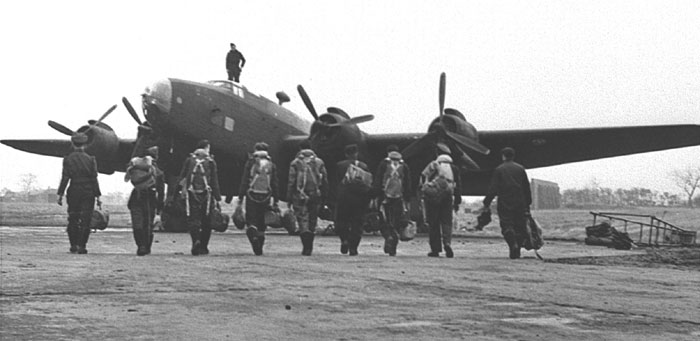

Inevitably, there were crashes as crews flew into the ground attempting to land or simply ran out of fuel. This scene was repeated many times around the bomber airfields and adjacent countryside on the night of 16-17th December 1943. Nonetheless, the FIDO system saved several aircraft that night when they were diverted from fog-bound airfields. Landing with FIDO could be a frightening experience with considerable turbulence caused by the heat and the obvious risk from the fire if the aircraft did not remain on the runway. When the pumps were running, a fine jet of petrol from holes in the pipes could be set alight, creating a flare path and a wall of flame down the sides of the runway, the heat being intended to disperse fog and low cloud. FIDO was a system of large pipes laid down both sides and across the threshold of the main runway on each of these airfields, carrying thousands of gallons of petrol. The new Fog Investigation and Dispersal Operation (FIDO) system was operational at only three airfields: Graveley in Huntingdon, Downham Market in Norfolk, and Fiskerton, close to Lincoln. A Lancaster practising a FIDO landing at Graveley during daylight. To make matters worse, the barometric pressure had changed considerably since take-off and the crews had then been passed an incorrect altimeter setting by radio, which in some cases gave an altimeter error of up to 1,000 feet. The margin for error was exceedingly small and each failed attempt brought an increase in danger as the exhausted crews burnt up their remaining petrol, whilst 12 to 15 other aircraft were stacked up at different heights in the hold all running short of fuel and all wanting to get down as quickly as possible, creating a real risk of collision. At approach speed a Lancaster would cross the airfield in little more than 30 seconds if incorrectly lined up or if the pilot could not see the runway. In practice, SBA approaches in these conditions were extremely difficult to complete successfully. Referred to as “landing on the beam”, SBA employed signals emitted by beacons in line with the main runway. Due to the cloudy conditions en route the crews had to rely on dead reckoning navigation and the Gee radio navigation aid to find their bases and then had to attempt to land using the Standard Beam Approach (SBA). In some places it was a real ‘pea-souper’, with extremely poor visibility in which driving a car would be difficult, let alone trying to land a heavy bomber, possibly with damage, at 100 mph. When the surviving bombers returned to England their crews found that, in many cases, their airfields were shrouded in thick fog and very low cloud. On return from Berlin many Lancaster crews had to try to land using the ‘Standard Beam Approach’ in thick fog and low cloud.

The effect of the bombing campaign against Berlin had now made more than a quarter of the living accommodation in the city unusable. The raid was effective to some degree damage to the Berlin railway system was extensive and 1,000 wagon-loads of war material destined for the Eastern Front were held up for six days, the National Theatre and the building housing Germany's military and political archives were both destroyed. 207 Sqn Lancasters bombing Berlin in late 1943 (Artwork by Adam Tooby) Although the bomber stream shook off the pursuers on the return flight, by taking a northerly route over Denmark, 23 Lancasters were shot down over enemy occupied territory, with the deaths of 148 men, whilst 17 bombers returned with damage from enemy flak or fighters. The Germans were able to plot the bomber stream with great accuracy, to guess the target, and to direct night fighters to intercept the bombers. Their route led directly across the North Sea, over Holland and Northern Germany.

The Lancasters took off from their bases in England between 16:00 and 17:00 for the seven and a half hour flight to Berlin and back. On the night of 16th December 1943 RAF Bomber Command mounted another raid on the German capital of Berlin, this time with 483 Lancasters and 15 Mosquitos. Thursday 16th December 1943 became RAF Bomber Command’s ‘Black Thursday’ when almost 300 RAF airmen lost their lives that night, half of them the victims of cruel British winter weather rather than enemy action. ‘Black Friday’ is now a well-known phenomenon in the UK and America, with sales bargains galore supposedly on offer, but 75 years ago the word ‘black’ attached to a day of the week had an entirely different and tragic meaning. Header image: As the Lancasters’ take-off time approached in the late afternoon of 16th December 1943 weather conditions were worsening and fog seemed likely, but was not forecast.


 0 kommentar(er)
0 kommentar(er)
